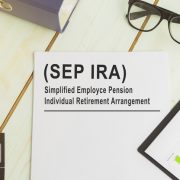The Self-Directed SEP IRA: Who is It For?
You have heard of Traditional IRAs, Roth IRAs, and 401(k) plans. But when it comes to a Self-Directed SEP IRA, who are the types of investors that might be suited for this investment vehicle, and might you qualify? If you want the advantages of a SEP IRA, it helps to know whether those advantages will make sense for you and your particular situation. Here’s everything you’ll need to know:
What is a Self-Directed SEP IRA?
The idea behind a Self-Directed SEP IRA is simple: this is a “simplified employee pension,” or SEP, packaged as an IRA. Here are some essential features of the SEP IRA you will want to note:
- Contributions to your SEP IRA are tax-deductible, giving yourself instant tax savings if you’re already contributing to investments in taxable accounts
- Investment growth within a SEP IRA are tax-deferred until retirement, when the distributions will then be taxed as income
- A SEP IRA is best for self-employed individuals, usually with small companies, even those without employees
Why is it important that you run a small company with few or no employees when using a Self-Directed SEP IRA? If you have what the IRS deems “eligible participants” in the plan—i.e., employees—then you need to make contributions to this plan on their behalf. See more information on eligible participants on the IRS website.
Contributions with a Self-Directed SEP IRA
Now let’s talk about one of the specific advantages of a Self-Directed SEP IRA: high contributions. Those with a traditional or Roth IRA understand that there’s only so much money each month before you press against those upper contribution limits. The SEP IRA has a great advantage in that its contribution limits will be much higher.
The IRS says that you cannot go over the amount of these two variables, whichever one is smaller:
- $56,000 in 2019
- 25% of compensation
As you can see, a potential limit of $56,000 is a tremendous amount of money on a per-year basis. If you have a successful company without a lot of employees, a Self-Directed SEP IRA allows you to put aside a tremendous amount of income into tax-deferred growth. That means you can instantly experience tax savings from some of your income (provided you invest it within a SEP IRA) and utilize the advantage you have with your higher income.
For this reason, the SEP IRA is often a great option for anyone with a thriving business that does not have a lot of employees. This may also apply for freelancers and other sole proprietorship enterprises for which there is not a lot of money to put away for employees, but plenty of income that can be set aside for the purposes of self-directing your retirement portfolio.
Why Choose a Self-Directed SEP IRA?
The Self-Directed SEP IRA is simple to set up, easy to administer, and allows you to deduct up to 25% of your net self-employment income in some situations. And because you do not have to contribute if you do not want to, it’s a no-brainer approach for retirement for many people, especially those who have small companies that are succeeding with plenty of income.
With a Self-Directed SEP IRA, you are also free to choose your own investments. That means leveraging the tremendous contribution advantages and turning them into assets such as real estate or private loans within the account. This opens up lots of flexibility with your retirement strategy and helps you hedge against big swings in the stock market. Having a well-funded retirement in a diversified portfolio helps you to grow a substantial nest egg, even if you work for yourself.
For more information, consult the IRS website as it relates to Self-Directed SEP IRA plans and what your limits may be. Interested in learning more about Self-Directed IRAs? Contact American IRA, LLC at 866-7500-IRA (472) for a free consultation. Download our free guides or visit us online at www.AmericanIRA.com.









